Ruled over by the Habsburgs who for centuries collected palaces and paintings, the concentration of art and architecture, museums and concert halls, can leave the first time visitor to Vienna in a daze. The capital of the Austro-Hungarian Empire until 1918, Vienna, to most people, signifies Strauss waltzes, opera, Wiener schnitzel and Sacher torte. It is an odd mix of things that blend together into an exotic whole, a city with which it is easy to fall in love.

Vienna, city of art, architecture and music - and those dancing horses
by Maritravel
Vienna, cultured, musical city of Strauss and Schubert, was once a downtrodden outpost of the Cold War. Today one wouldn't recognise that other Vienna. It is an exquisite jewel.
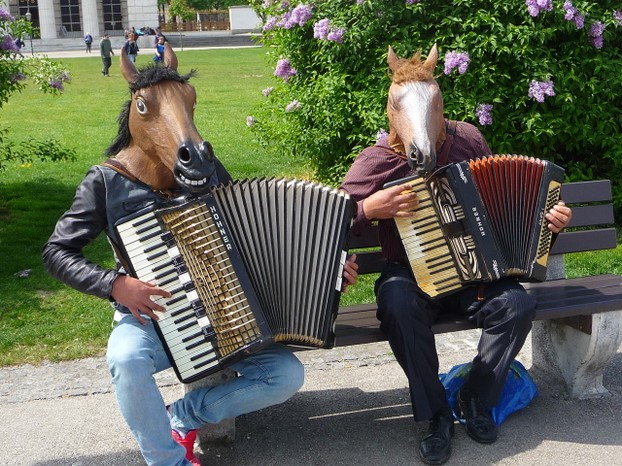 Entertainment in the Park, Vienna Mari Nicholson |
Where to Start in Vienna
Vienna is an easy city to negotiate: few cities lend themselves to walking from one famous sight to another so easily.
Where to start? A walk through the Stadtpark to view the sculptures and the golden statue of Strauss, avoiding the vendors in 18th century dress selling tickets for that night’s Viennese concert in one of the concert halls: coffee and Sacher torte in the Hotel Sacher: a visit to The Belvedere to see the famous Klimt painting The Kiss? Any of these will do for starters because, sooner or later, you will do them all.
Vienna’s like that. You arrive with a strictly prioritised list of things to do, but the vibrancy of the city, the accessibility of the major sights, and the easy walking, means that you soon throw the list away in favour of just wandering and doing things as and when they crop up.
While walking, tempting though it is to keep looking up at the architecture and statuary, glance down occasionally to notice the small brass cobblestones, called Stolpersteine (stumbling blocks) which are set into the pavement outside the homes from which Jewish, gay, socialist, Gypsy and other victims were sent to their murder during the Nazi period. Apparently there are now more than 48,000 of these remembrances in 18 countries.
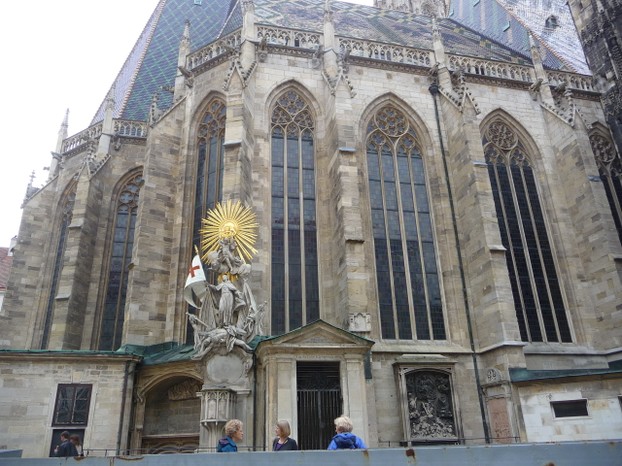 St. Stephen's Cathedral, Vienna Mari Nicholson |
St Stephen's Cathedral (Stephansdom)
Depending on where you are staying, you may like to start with a leisurely stroll through the lovely Stadtpark and then browse the enticing shops in the retail area, before heading towards St. Stephen’s Cathedral where you can pop in for a short rest (or a prayer if you are so inclined) before continuing sight-seeing.
The Cathedral, built in 1147, is more often referred to by its German name, Stephansdom. It has been the heart of the city for centuries and is one of Vienna's most famous sights. The gigantic roof and the tall tower are pointed out as two of the most important aspects of the cathedral but there are many art treasures to be found inside, like the tomb of Prince Eugene of Savoy (1754), the pulpit by Anton Pilgram (1514-15), the sepulchere of Emperor Frederik III, and the Gothic winged altar. The exterior is currently being cleaned up as the limestone from which it is built has become, in part, totally black over the centuries of its existence.
The area next to Stephansdom is known as the Blutgasse District and is a fascinating place in which to wander. Nooks and crannies, narrow, winding streets and medieval and baroque houses define the area and many of the beautiful courtyards are accessible to the public.
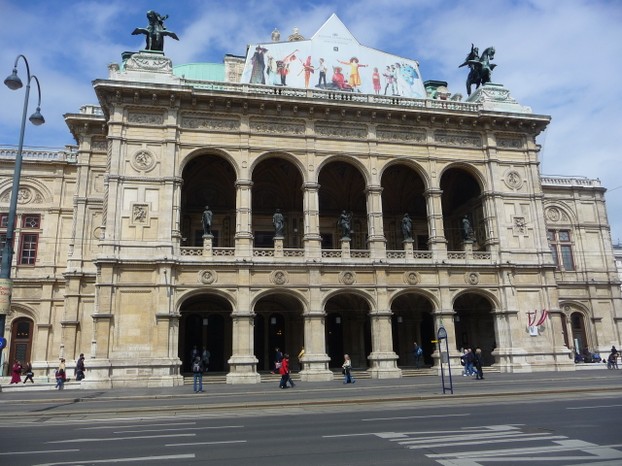 Opera House, Vienna Mari Nicholson |
Art and Opera in Vienna
Klimt at The Belvedere, Music at the Opera House
Not far from here are the Belvedere Palaces (often just referred to as The Belvedere), two magnificient palaces constructed for Prince Eugene of Savoy outside Vienna's defenses, but today not far away from the very centre of the city. Most visitors head for the upper Palace with its collection of 19th and 20th century Austrian paintings by artists of the Secession Movement, artists such as Gustav Klimt (1867-1918), Egon Schiele (1890-1918) and Oskar Kokoschka (1886-1980).
Classic paintings lead to classic opera which, in Vienna, can be extremely grand, but while the music is always wonderful, not everyone dresses up although no one actually dresses down either. Don’t be surprised to see jewels and furs worn even on warm evenings and if you see someone in very casual attire, you can be sure he or she is a tourist..
Concerts of Viennese music are a daily/nightly event but can be slightly touristy. Make enquiries before you buy your ticket to ensure you are getting a proper music concert, not one with dancers and singers slotted on. Ticket sellers dressed like 18th century Regency dandies hover outside the concert hall and the Opera House so you can usually get a ticket for one of the performances.
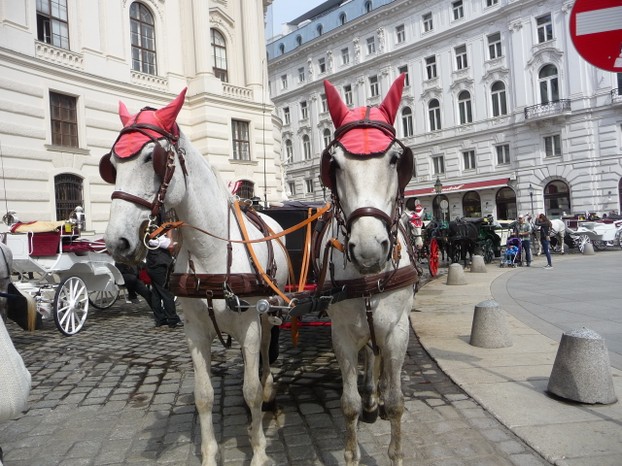 Hofburg Palace with Horse and Carriage, Vienna Mari Nicholson |
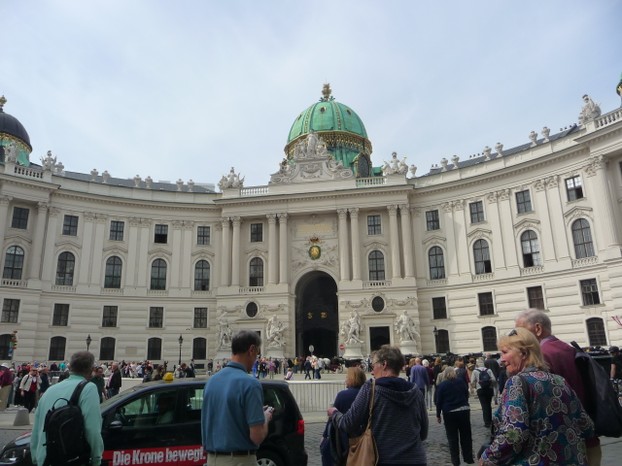 Hofburg Palce Mari Nicholson |
Hofburg Palace and the Spanish Riding School
Lipizimmer Horses and the Vienna Boys Choir
As a change from cerebral events you could hop on a tram or a bus, or hail a taxi to the Hofburg Palace where the Spanish Riding School is housed. This world famous horse show, a sort of Strictly Come Dancing for Horses, but without the frocks is, for many visitors to Vienna, an absolute must. Go for the 10 a.m. ‘training session’ if you want to save money as it is terrific value compared to the cost of a ticket to the finished event. You will see the elegant 18th-century indoor riding school in the palace complex, and also see the Lipizzaner horses do many of their tricks. There is no guarantee as to what the practice session will involve, but then there is no guarantee what will be in the evening programme either.
The Hofburg was originally a medieval castle, but today it displays almost every architectural style, from Gothic to Art Nouveau due to constant additions. Nowadays this enormous complex houses the Austrian National Library, the Imperial Treasury, and a collection of musical instruments, a collection of weapons, a Museum of Ethnography and the Spanish Riding School.
If possible, go on a Sunday to hear Mass at the medieval chapel and listen to the renowned Vienna's Boys Choir.
Heroes Square is impressive, with equestrian statues of Archduke Karl, who won the Battle of Aspern against Napoleon's troops (1809), and Prince Eugene of Savoy, who defeated the Turks.
The Third Man and the Cold War,
Harry Lime, Kim Philby and Post-War Vienna
Metternich is credited with saying, “The East begins at the Landstrasse,” the city’s south-east side. Many people have forgotten, many more aren't even aware, that Vienna, after the end of the Second World War, was one of the cities divided between the four Great Powers, Russia, USA, United Kingdom, and France. Was it that nearness to the east and the consequent edginess that led the spy, Kim Philby, to develop his trade there? It is said he was part of the inspiration for the film,The Third Man.
To learn something of those times, head for The Third Man Museum, privately owned and dedicated to the film of the same name. It is curated by a young couple who have devoted years of their lives to collecting memorabilia about that iconic Carol Reed film (starring Joseph Cotton, Orson Welles, Alida Valli and Trevor Howard) in every language - posters, music, cameras, everything you could possibly want to see - and now house them under one, or 3 roofs to be exact. This 1949 classic film gives a fascinating insight into a Vienna divided between the Allies, at a time when the cold war was cementing the city's reputation as a shadowy outpost of the rest of Austria. The Third Man Museum has one whole section devoted to the lives lived in Vienna during the Cold War.
Follow this with The Harry Lime Third Man Walking Tour which retraces Harry Lime’s footsteps through the city’s cobbled streets, visiting many of the original locations and telling the tales of the black market, spying and hardships of post-Second World War Vienna. If you are a fan of the film, or just want a historic tour with a twist, it’s a must. Then once home in your own country, watch the film again – you’ll be surprised how much more you get from looking at it from this new perspective.
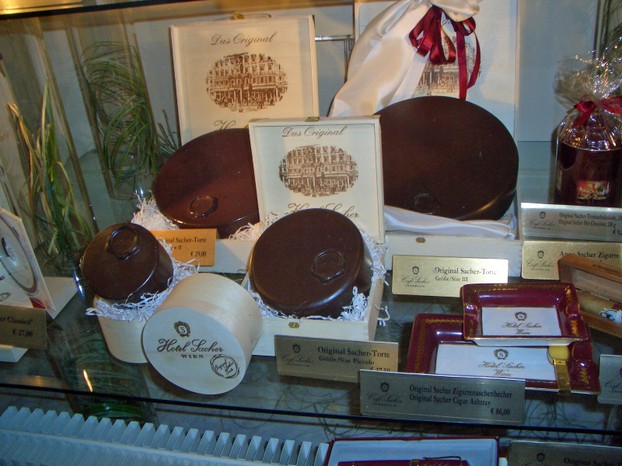 A Window Full of Heaven - Sacher Torte |
Food, Glorious Viennese Food
Wiener Schnitzel and Sacher Torte
But Vienna is about more than just classic architecture and historic palaces and houses. There is the calorie-laden food, the coffee houses, and the chocolates! It’s a gourmet’s delight and whether you opt for coffee and Sacher torte at the famous Hotel Sacher (highly recommended even if one does have to queue for maybe half an hour to get a seat), or try a delicious strudel at one of the many great sidewalk cafes, you are sure to be delighted. For dinner, if one doesn’t have a reluctance to eat veal, the ultimate dish in Vienna is Weiner Schnitzel, that highly calorific boneless cut of veal, doused in egg and rolled in breadcrumbs before being fried. Many countries lay claim to having invented this, Spain via the Moors, the Jewish community in Constantinople in the 12th century or the more up to date legend of its import from Italy to Austria by Field Marshal Radetzky. Many places serve this famous dish but one of the best restaurants in which to try it is Schnitzelwirt on Neubaugasse.
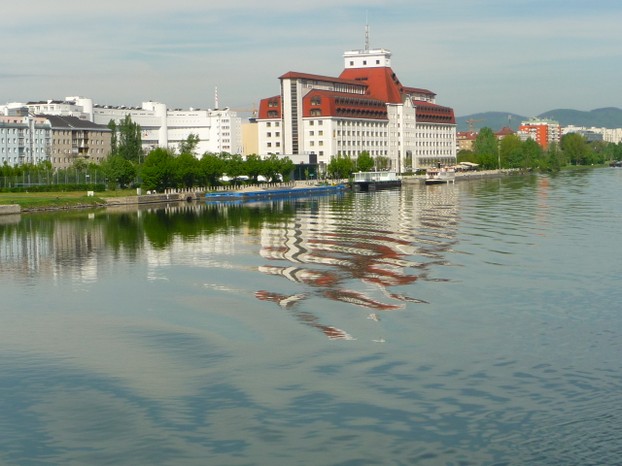 Blue Danube River Mari Nicholson |
The Blue Danube and The Vienna Woods
It is said that traditional Viennese cuisine really requires you to burn 10,000 calories a day. Probably, if you were to indulge in some of the other dishes like farmer’s feast (a massive collection of pork, sauerkraut and other calorie-laden foods), or pig’s lung with gorgonzola (the whole washed down with the excellent local beer), it might be necessary. If you need to burn this 10,000 calories a day then the best way is a jog along the Danube riverbank, or hire a cycle and ride along the towpath by the fast flowing waters (cycle hire is easily available in Vienna).
If you just want to enjoy the Blue Danube, then you can take a boat ride on the river, available from various points: you can even take a trip down to Salzburg or Bratislava if you have the time and want to do more exploring.
Or, on a fine day, nothing beats a trip into the green wonderland of the Vienna Woods.
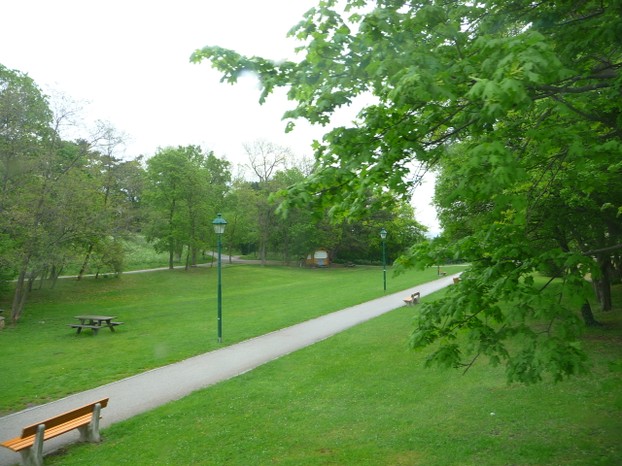 Vienna Woods after the Rain, Green, Green, Green Mari Nicholson |
For the Opera, a special box office on Operngasse opens 80 minutes before performances and you can get a standing ticket for €3 or €4.
Vienna Tourist Board http://www.vienna.info/en
You might also like
Salzburg - The Sound of MozartIt shares with Vienna the reputation of being a musical city par excellence, ...
Affordable Italy: 6 Tips for Traveling on a BudgetVisiting Italy is a dream of many...but is it too expensive to turn into a re...
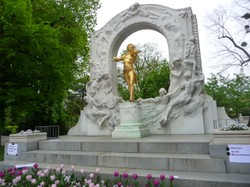

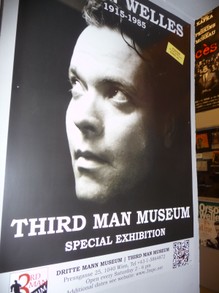
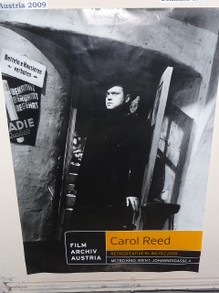
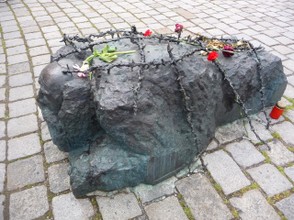
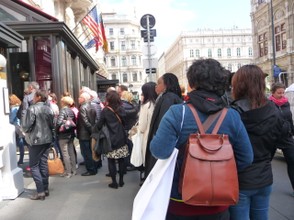
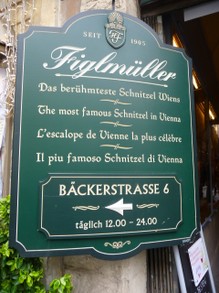

 The Alternative Picture Galleryon 04/20/2016
The Alternative Picture Galleryon 04/20/2016
 ROME - Where the Past Comes to Lifeon 03/26/2016
ROME - Where the Past Comes to Lifeon 03/26/2016
 Only in London - New Unique Guideon 01/25/2016
Only in London - New Unique Guideon 01/25/2016
 Manna, from Sicily, not from Heavenon 01/08/2016
Manna, from Sicily, not from Heavenon 01/08/2016
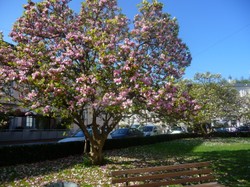
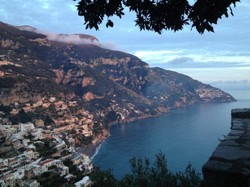
Comments
Hi Veronica, Great that you enjoyed the Historic Dockyard. It's somewhere I have to go every year when various young members of the family turn up during school holidays, but I love it anyway. In case you didn't see it, here's the link to my article on the Mary Rose, written just after the opening last year. I am also attaching a link to my Salzburg piece in case you want to read that. Thanks for reading so far. I've clicked to follow you too.
https://wizzley.com/salzburg-mozart-m...
https://wizzley.com/the-mary-rose-mus...
(ASIDE ; I see you are on the isle of Wight. WE visited Portsmouth on our holidays this year. The Historic dock is amazing. :)
I love the long pieces and I love knowledge and learning.
On a lighter note my favourite film is Sound of Music which was filmed in Salzburg Austria. Stunning location.
Nice read, Mari! I visited Vienna several times but there are still things I need to see. Thank you for this article :)
Thank you, Veronica. And thank you for reading such a long piece.
absolutely lovely. ty Mari.
Austria is beautiful and unspoilt and you ave described perfectly .
Thank you both. My first bit of 'long writing' for Wizzley as I think people are more inclined to read short pieces, i.e. about 800 words or so. Glad you made it to the end!
What a fabulous article! I was overwhelmed with the breadth of experiences waiting to be enjoyed. Sobered by the pebbles, amused by "Strictly Come Dancing for horses but without the frocks." Thanks for such an enjoyable cyber tour.
This looks like a place worth visiting. The images alone make its case.